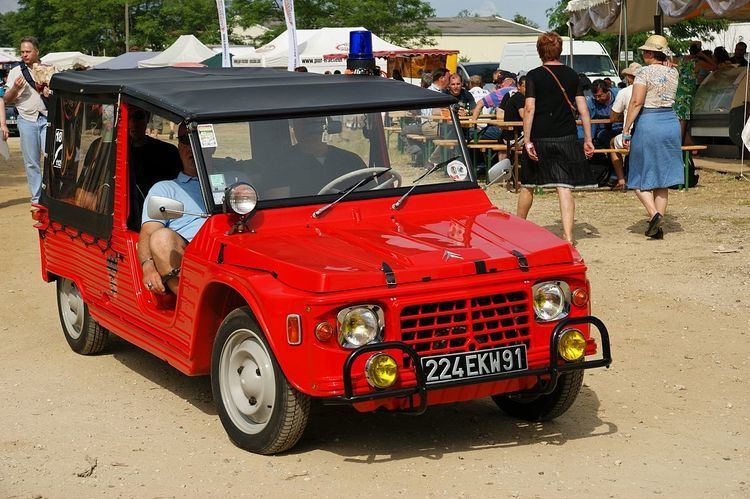Designer Roland de La Poype | Production 1968—1988 Body style 2-door cabriolet SUV | |
 | ||
Assembly Belgium: ForestSpain: Vigo (Centro de Vigo)Portugal: MangualdeArgentina: (Citroen Argentina, S.A./IES) Class Off-road compact SUV (J) | ||
The Citroën Méhari was an off-road compact SUV produced by the French car maker Citroën, a variant of the Citroën 2CV. 144,953 Méharis were built between the car's French launch in May 1968 and 1988 when production ceased. A méhari is a type of fast-running dromedary camel, which can be used for racing or transport. A méhariste was a French Armée d'Afrique and Army of the Levant cavalryman that used these camels.
Contents
- Origin
- Post production
- Mhari 4x4
- Limited editions
- United States
- South America
- Military
- Colours
- Paris arson incident
- References
The Méhari was based on the Citroën Dyane 6, and had a body made of ABS plastic with a soft top. It also employed the 602 cc flat twin petrol engine shared with the 2CV6 and Citroën Ami. This is similar to the way the mechanical parts of the 1960 Mini became the 1964 Mini Moke.
A four-wheel drive version of the Méhari was produced from 1980 to 1983 and had excellent off-road qualities, due to the lightness of the vehicle.
The standard Méhari weighs 535 kg (1,179 lb) and has the interconnected fully independent long-travel 2CV suspension used by all of the Citroën 'A-Series' vehicles.
Origin
The Méhari was designed by French World War II fighter ace Count Roland de la Poype, who headed the French company SEAP - Société d'Etudes et d'Applications des Plastiques. This company was already a supplier to Citroën, and SEAP developed a working concept of the car before presenting it to its client.
Post-production
The Méhari ended production in 1988 with no replacement. This left a gap in the market, that others have tried to address.
The Teihol company, which had been building the recently defunct Renault Rodeo, created the Tangara using 2CV mechanicals, with bolt on pre-dyed GRP panels. It also created a Citroën AX-based model. The company ceased operations in 1990.
Due to its mechanical simplicity the Méhari can be restored to ‘as new’ condition – all parts including the chassis are easily available, creating a thriving restoration market.
Méhari 4x4
In 1979, Citroën launched the Méhari 4x4 with drive to all four wheels. Unlike the Citroën 2CV Sahara 4x4, this car had only one engine, rather than one engine per axle.
The body is distinguished by its spare wheel mounted on the specially designed bonnet, its additional bumpers, front and rear, its flared wheel arches (for 1982), big optional tyres (for 1982) and tail lights similar to the Citroën Acadiane van. The 4x4 version has a gearbox with four normal speeds and a three-speed transfer gearbox for crossing slopes up to 60%. At the time, the Méhari 4x4 was one of the few 4x4s with four-wheel independent suspension. The car had all wheel disc brakes.
Méhari 4x4 production stopped in 1983. With about 1,300 vehicles produced, the 4x4 is now highly sought after and transmission parts are virtually unobtainable.
Limited editions
Two limited edition versions of the Méhari were sold: the first was the white and blue Méhari Azur (Blue), of which 700 were sold, and the all-yellow Méhari Plage (Beach), produced for the Spanish and Portuguese market.
United States
The Méhari was sold in the United States in 1969 and 1970, where the vehicle was classified as a truck. As trucks had far more lenient National Highway Traffic Safety Administration safety standards than passenger cars in the US, the Méhari did not have seat belts. Budget Rent-A-Car bought some and offered them as rentals in Hawaii. Hearst Castle, in San Simeon, California, used them as groundskeeper cars.
Distinctions for the US-model included:
South America
The Méhari sold in Argentina had a fibreglass body rather than ABS. The car was produced in Uruguay from 1971 to 1979. After Citroën left Argentina following the collapse of the economy in the late 1970s, the production of the Méhari, renamed the "Méhari Ranger" with flared wheel arches and big tires, continued for some time.
Military
The French Army purchased 7,064 Méharis - some of which were modified to have 24 V electric power. The Citroën Méhari was also in service with the Irish Defence Forces, which bought a total of 12 vehicles in the late 1970s; most were sold at auction about 1985, but one is retained at the DFTC in the Curragh Camp, County Kildare, Ireland.
Colours
The car's colour was integrated into the ABS plastic material in production, and as a utilitarian vehicle, the options chart was quite limited. Only Vert Montana remained in the catalogue for all the 18 years of production. Except for the limited edition Azur, the official names of colours all refer to desert regions.
Ultraviolet rays from the sun impact the colorfastness of ABS plastic, so unrestored cars have a faded appearance. New bodies for restorations are only supplied in white, and now require painting on top of a specialist primer.
